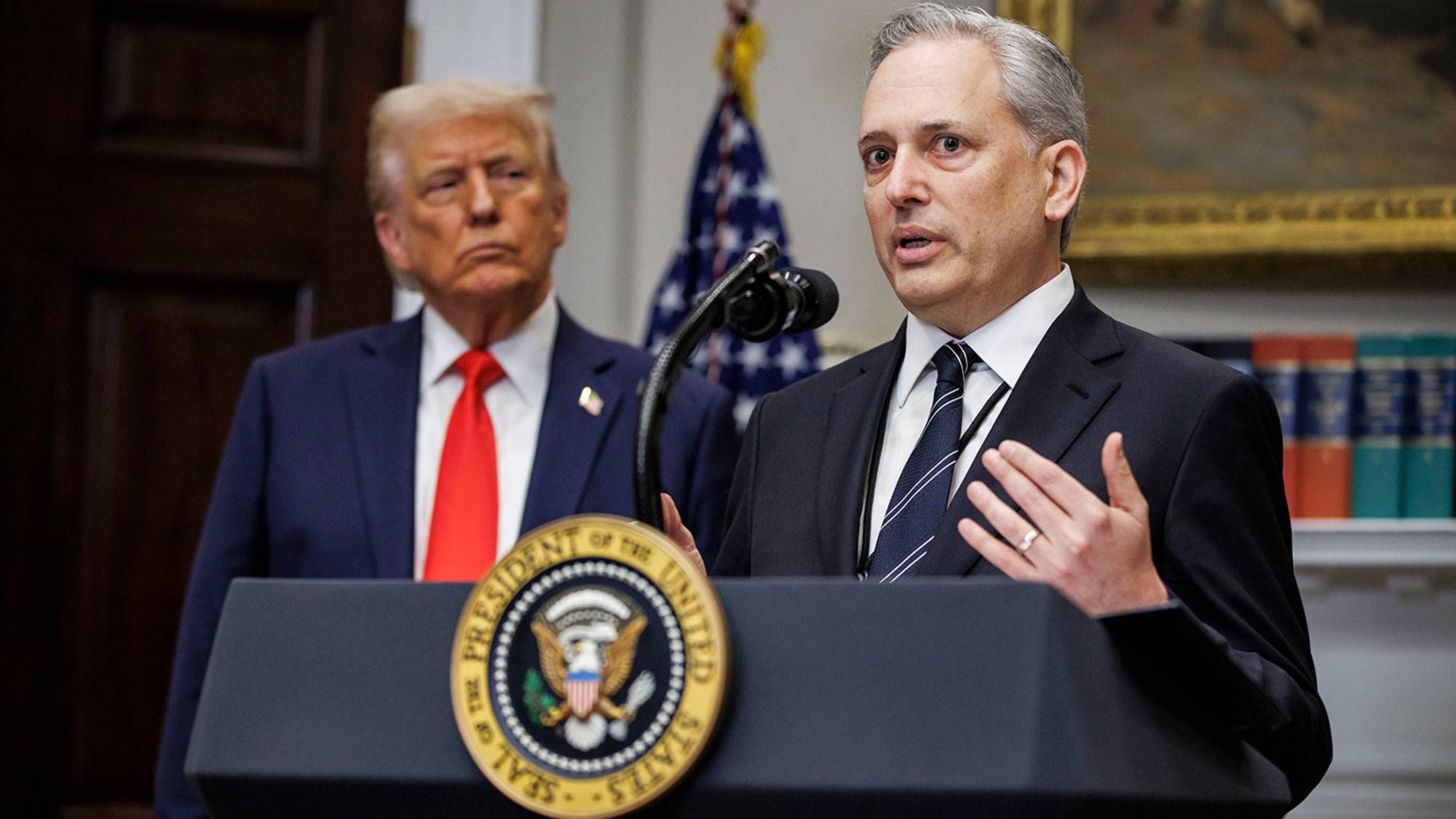Buy-to-let mortgages pulled at fastest rate since 2009
Dramatic fall follows changes in tax regulations and tough new affordability tests from the Bank of England

Conflicting evidence on effects of buy-to-let clampdown
3 February
A clampdown in the form of hefty, punitive tax changes on buy-to-let purchasers of second homes could see as many as half a million homes flood the market in the next year, it has been claimed.
The National Landlords Association conducted a survey among its members and estimates that 500,000 homes could be sold in the coming 12 months, with another 100,000 per year until 2021, according to The Times. It said the number of landlords looking to sell had doubled as confidence in buy-to-let as an investment fell to a post-financial crisis low.
The Week
Escape your echo chamber. Get the facts behind the news, plus analysis from multiple perspectives.

Sign up for The Week's Free Newsletters
From our morning news briefing to a weekly Good News Newsletter, get the best of The Week delivered directly to your inbox.
From our morning news briefing to a weekly Good News Newsletter, get the best of The Week delivered directly to your inbox.
This follows two major tax changes announced in the July budget and the November Autumn Statement last year, which will reduce the yield of rental income by reducing mortgage interest relief and ramp up the up-front tax bill for buyers by introducing a three per cent stamp duty surcharge.
In some respects, the sale of a number of buy-to-let properties is the idea of the reforms. It will significantly increase the supply of homes onto the market, hopefully including a swath of smaller homes ideal for first-time buyers, which should also in turn slow the pace of house price gains that are squeezing affordability. In fact, some say it could swing price inflation into reverse.
However, there is also considerable doubt over the effects of the proposals and conflicting evidence is emerging. Moneyfacts.co.uk reports that buy-to-let mortgage rates are still falling and are "historically low", while the number of loans available is booming.
It says this reflects intense competition for business amid a huge surge in demand, particularly from landlords looking to secure a sale before the change in stamp duty takes effect on 1 April. This ties in with wider evidence showing an acceleration in house price growth in December and January.
A free daily email with the biggest news stories of the day – and the best features from TheWeek.com
While a short-term burst of activity to clear sales ahead of April would be necessarily short-lived, it also suggests buyers still see the long-term prospects for buy-to-let despite the more fundamental changes to the interest relief rules. If that remains the case, it is unlikely there will be a substantial net sale of homes in the months and years ahead.
Will buy-to-let face more curbs from the Bank of England?
26 January
All eyes are on the buy-to-let sector as the market gauges the impact of a two-pronged tax clampdown by George Osborne, which takes effect from April.
Things could get even worse for those with aspirations to become a private landlord. The Financial Times reports that Bank of England governor Mark Carney is due today to appear before the Treasury select committee, against the backdrop of a future consultation on handing the Bank more powers to curb lending, including placing restrictions on lenders or requiring buyers to undergo tougher affordability tests.
It comes after the Bank again cited the sector as a key risk to the economy in its latest financial stability report in December. Its research shows as many as 15 per cent of buy-to-let owners might sell if their mortgage interest was no longer covered by rental income – and 45 per cent might do so if house prices dropped ten per cent.
Private landlords now make up one in five property owners. Policymakers fear the huge rise in landlord lending in recent years, in a sector unconstrained by the affordability assessments for residential buyers and where most loans are interest-only, could amplify a turn in house prices and trigger a severe slump.
Ray Boulger, the technical director at the mortgage broker John Charcol and a well-known industry commentator, told the FT that extra powers for the Bank's financial policy committee "look like a done deal". He added, though, that even if this is the case, they would be unlikely to use them for many months yet until the market settles following the Chancellor's own assault.
From April, buyers of buy-to-let or any other second home will have to pay three per cent more in stamp duty at each price banding. On a home worth £250,000, this will boost the tax bill by £7,500 to a total of £10,000. The amount of tax relief on mortgage interest will also be tapered down to 20 per cent by 2020, halving the relief for higher-rate taxpayers.
The Daily Mail cites evidence, this time anecdotal research gathered by the Association of Residential Letting Agents, that more buy-to-let investors are rushing to secure a home ahead of April. Longer term, the cumulative effect of the changes could be fewer private landlords in the market, which might help to slow house-price gains.
Buy-to-let investors surge to beat 'landlord tax'
21 January
George Osborne is "repeating the mistake of his predecessor Nigel Lawson", Peter Spencer, professor of economics at the University of York, told the Financial Times.
Lawson, Conservative chancellor under Margaret Thatcher, "set an August deadline for cohabiting couples to claim double mortgage interest relief in his 1987 budget", creating a market-distorting rush to secure sales, said Spencer. The incoming "landlord tax" imposed at the Autumn Statement in November similarly "guarantees a bunfight in the first quarter followed by a relapse over the rest of the year", he added.
Under the plans, buy-to-let investors will have to pay an additional three per cent stamp duty surcharge. This adds a £3,000 tax bill to the purchase of a £100,000 home that would normally be free of stamp duty - and no less than £7,500 to a home worth £250,000, making a total bill of £10,000.
The measure, which comes into force in April, is aimed at curbing the rapid growth of private landlord buying, but affects all second-homes buyers.
Reuters says such sales made up a quarter of the market last year, far more than in most other advanced economies and a major cause of rising prices that are squeezing younger first-time buyers out of the market.
Spencer's words appear prophetic. Last week, the Council for Mortgage Lenders revealed a late surge had pushed buy-to-let lending up 35 per cent year-on-year in November. Now new figures from the Royal Institution of Chartered Surveyors (Rics) reveal buyer enquiries were at a three-month high in December, driven by demand from would-be landlords seeking to complete before the tax comes into force.
The surcharge is not the only tax change hitting buy-to-let. In his earlier budget in July, Osborne announced that investment owners would be restricted to a flat 20 per cent rate of relief on mortgage interest, effectively halving relief for higher-rate taxpayers. They'll also be assessed for tax before the relief is deducted, pushing more into the higher rate bracket.
Some said the change would prompt a major slowdown in the sector, but for the moment that is not happening. Rics did note, however, an increase in new instructions in December for the first time since last January, which could be the first sign of landlords worried about yield seeking to exit the market.
Should this happen – or if buy-to-let slows markedly post-April – then it should serve to remove some of the heat from the housing market and slow price growth.
How buy-to-let landlords are getting around looming tax hikes
14 January
The death of the buy-to-let mortgage has, it appears, been much exaggerated.
Many press reports had indicated that lending to prospective private landlords might wither as a result of a double whammy of tax increases between December's Autumn Statement and the Budget last July. Existing borrowers were also said to be likely to trigger a fire sale of property assets that would drag back prices.
However, the demand to invest in housing at a time of low interest rates and choppy stock markets is showing no signs of letting up. Instead, landlords are seeking to find ways to avoid the tax hikes.
Firstly, they are seeking to get ahead of a 3 per cent stamp-duty surcharge coming into force in April by rushing to secure mortgages in the wake of November's shock announcement. New figures from the Council for Mortgage Lenders, reported by the BBC, show the number of buy-to-let loans advanced in November was up 35 per cent from a year earlier.
Mark Harris, chief executive of mortgage broker SPF Private Clients, said this showed not only a desire to secure a property before a change that would add a one-off £7,500 tax charge to a £250,000 home, but also that the market currently boasts "some of the cheapest buy-to-let rates ever".
Elsewhere, the Daily Mail reports that "crafty buy-to-let landlords" are increasingly using limited company structures to avoid changes that will cut the tax relief they can claim against mortgage interest. The proportion of loans advanced to companies rather than individuals has more than doubled, from 15 per cent last October to more than a third now.
Under the changes, landlords will not be able to deduct mortgage interest from their rental income before it is assessed for tax but will instead get a flat rate 20 per cent tax credit. This means those paying higher-rate tax will lose half of their relief, while some others will be moved up into this bracket and so see their tax bill soar (see the second page of this article for an example).
Using a company structure means interest, which is classed as a business expense, can still be deducted. Corporation tax would also apply that would reduce a higher-rate taxpayer's rate from 40 to 20 per cent – and to boot, the Mail says some lenders are making the mortgage rates cheaper for limited companies to capitalise on demand.
While these avoidance mechanisms will be seen as positive by buy-to-let landlords or others with a vested interest in property prices remaining high, those who want the measures to ease prices and help under-pressure first-time buyers will be hoping the government acts to close any loopholes.
-
 Trump vs. states: Who gets to regulate AI?
Trump vs. states: Who gets to regulate AI?Feature Trump launched a task force to challenge state laws on artificial intelligence, but regulation of the technology is under unclear jurisdiction
-
 Decking the halls
Decking the hallsFeature Americans’ love of holiday decorations has turned Christmas from a humble affair to a sparkly spectacle.
-
 Whiskey tariffs cause major problems for American distillers
Whiskey tariffs cause major problems for American distillersIn the Spotlight Jim Beam is the latest brand to feel the pain